Bridgend & Cowbridge, Glamorgan
Up to 1834
Parish workhouses existed at Bridgend (Lower Coity), Cowbridge, Llantwit Major, Newton Nottage, St Athan, and St Brides.
After 1834
Bridgend and Cowbridge Poor Law Union was formed on 10th October, 1836. Its operation was overseen by an elected Board of Guardians, 52 in number, representing its 52 constituent parishes as listed below (figures in brackets indicate numbers of Guardians if more than one):
County of Glamorgan Bettws, Colwinstone, Cowbridge, Cwmdu, Eglwys Brewis, Ewenny, Flemingstone, Gilestone, Higher Coychurch, Higher Coyty [Coity], Higher Newcastle, Higher Tythegston, Kenfig, Laleston, Lisworney, Llanblethian, Llandough, Llandow, Llandyfodwg, Llangan, Llangeinor, Llanharan, Llanharry, Llanilid, Llanmaes, Llanmihangel, Llansannor, Llantwit, Major, Lower Coychurch, Lower Coyty, Lower Llangynwyd, Lower Newcastle, Lower Tythegston, Marcross, Merthyrmawr, Middle Llangynwyd, Monknash, Newton Nottage, Penlline, Peterston-super-Montem, Pencoed, Pyle, St Athan's, St Brides, Minor, St Brides (including St Brides, Lampha and Southerndown), St Donats, St Hilary, St Mary Church, St Mary Hill, Wick, Ynysawdre, Ystradowen.
The population falling within the union at the 1831 census had been 17,012 with parishes ranging in size from Eglwys Bewis (population 15) to Lower Coyty (1,165). The average annual poor-rate expenditure for the period 1834-36 had been £6,879 or 8s.1d. per head of the population.
A Bridgend & Cowbridge Union workhouse for 200 inmates was erected in 1836-8 at the east side of Quarella Road in Bridgend. The Poor Law Commissioners authorised an expenditure of £4,400 on construction of the building which was intended to accommodate 200 inmates. It was designed by George Wilkinson who was the architect of many other union workhouses in England and Wales including those at Neath and Cardiff. The Bridgend & Cowbridge workhouse, built in his favoured Elizabethan style, also foreshadowed the appearance of the workhouses in Ireland, almost all of which were designed by Wilkinson.
Bridgend & Cowbridge followed the Commissioners' model cruciform or "square" layout with separate accommodation wings for the different classes of inmate (male/female, infirm/able-bodied etc.) radiating from a central hub. Its location and layout are shown on the 1938 map below:
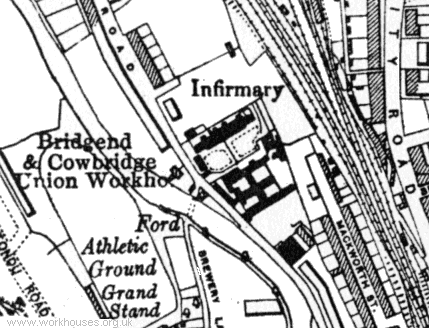
Bridgend workhouse site, 1938.
The entrance block lay across the south of the site. This originally had a two-storey central portion, nine bays wide, with single storey extensions at each side. The central portion had two doorways, one for males at the left and one for for females at the right. The porter's lodge lay in-between the two.
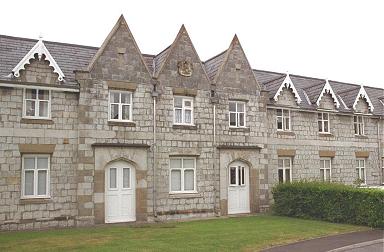
Bridgend & Cowbridge entrance from the south, 2000.
© Peter Higginbotham.
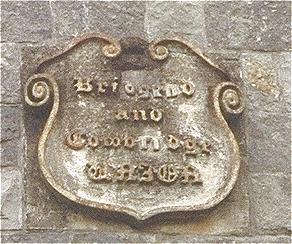
Bridgend & Cowbridge, 2000.
© Peter Higginbotham.
On the men's side, moving away from the entrance, were the male admissions' ward, the old men and young boys' ward, then a younger men's ward in the single storey portion. On the women's side, the two storey section contained a mother and young children's ward. The single storey sections of the entrance block were later replaced by two-storey sections.
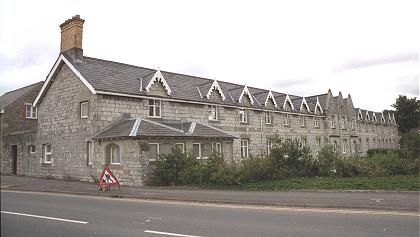
Bridgend & Cowbridge entrance block from the south-west, 2000.
© Peter Higginbotham.
To the rear of the entrance block were male and female exercise yards. These were separated by a range containing the chapel/dining hall which connected to the workhouse's three-storey central hub. The octagonal hub had kitchens on its ground floor and observation windows which allowed the yards to be supervised from the upper floors. Male and female accommodation wards ran from each side, parallel to the entrance block.
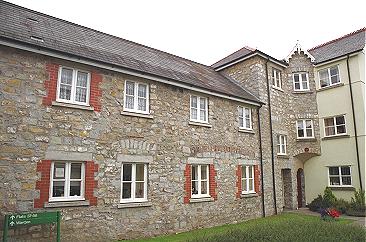
Bridgend & Cowbridge east wing from the north-east, 2000.
© Peter Higginbotham.
A further range running northwards contained a school room. Apparently (Thomas and Wilkins, 1995), the Guardians soon decided that the schoolroom should be turned into the workhouse chapel and to do without a schoolroom. A vagrants' ward was erected along the Quarella Road edge of the site.
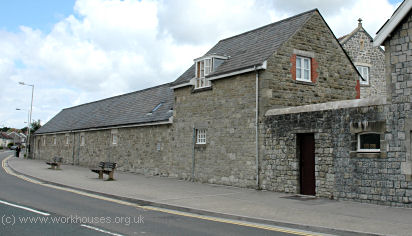
Bridgend & Cowbridge Union vagrants' ward and porter's house, 2005.
© Peter Higginbotham.
In 1911, a new union offices building was erected just to the south of the workhouse.
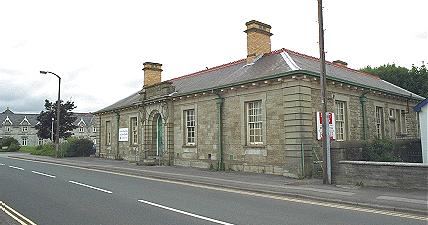
Bridgend & Cowbridge Union Offices from the south-west, 2000.
© Peter Higginbotham.

Bridgend & Cowbridge Union Offices entrance, 2000.
© Peter Higginbotham.
Expansion of hospital facilities took place at the north of the workhouse, with the site later becoming Bridgend General Hospital.
The surviving workhouse buildings have now been converted for use as accommodation for the elderly.
Bridgend Cottage Homes
In January, 1879, the Bridgend Union opened a group of cottage homes for the accommodation of pauper children. These were located at the east side of Merthyr Mawr Road to the south of Bridgend. The site location and layout is shown on the 1921 map below.
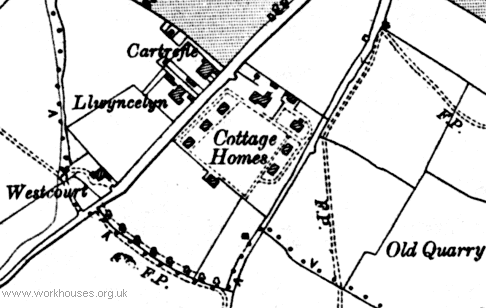
Bridgend cottage homes site, 1921.
The six homes, each accommodating ten children, together with school and administrative blocks, were arranged around a "village green". They scheme was designed by Mr Harris and the building contract of £4,940 was awarded to William David of Newcastle Hill.

Bridgend cottage homes from the south-east, c.1913.
© Peter Higginbotham.
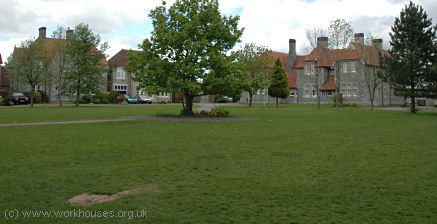
Bridgend cottage homes, 2005.
© Peter Higginbotham.
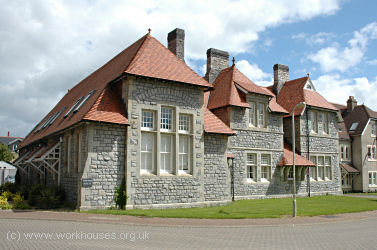
Bridgend cottage homes adminstrative block, 2005.
© Peter Higginbotham.
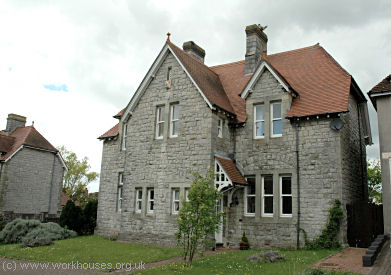
Bridgend cottage homes children's house, 2005.
© Peter Higginbotham.
The former homes are now in private residential use.
Staff
Inmates
- Long-term workhouse inmates (1861)
- Bridgend Workhouse 1881 Census
- Bridgend Cottage Homes 1881 Census
Records
Note: many repositories impose a closure period of up to 100 years for records identifying individuals. Before travelling a long distance, always check that the records you want to consult will be available.
-
Glamorgan Archives, Clos Parc Morgannwg, Leckwith, Cardiff CF11 8AW.
Holdings include:
- Guardians' minute books, (1836-1930)
- Workhouse admissions and discharges, (1921-1930, with gaps); Register of lunatics (1890-1912); Registers of patients (1936-48); Births (1914-47); Deaths (1903-50); Maternity registers (1912-44); Creed registers (1904-34, with gaps); Register of Inmates (1930-32); Minutes of House Committee (1896-1931)
- Cottage Homes: Admission and discharges (1879-1946); Creed registers (1879-1919); Cottage Homes Committee minutes (1878-1930); Indoor Relief Lists (1931-48)
Bibliography
- Thomas, JH & Wilkins WE (1995) The Bridgend-Cowbridge Union Workhouse and Guardians (D Brown & Sons, Cowbridge)
- NEW! Workhouses of Wales and the Welsh Borders. The story of the workhouse across the whole of Wales and the border counties of Cheshire, Gloucestershire, Herefordshire and Shropshire. More...
Links
- None.
Acknowledgment
- Thanks to Glamorgan Record Office for information.
Unless otherwise indicated, this page () is copyright Peter Higginbotham. Contents may not be reproduced without permission.


